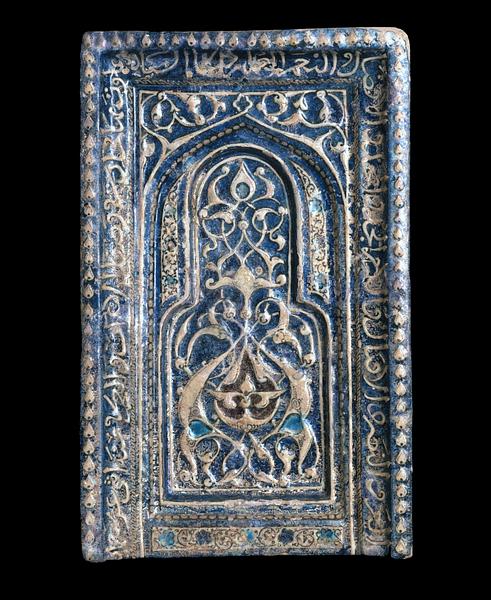Fritware mihrab tile, molded and painted in a white slip and in blue, black, turquoise, and manganese under a transparent glaze
Iran; 712 H = 1312
H: 53.5; W: 33; D: 6.5 cm
The mihrab, the niche found in mosques and other buildings to show the direction of Mecca, is often decorated with arabesques. This has led some to believe that the arabesque, which in principle can be extended infinitely, can be considered a symbol of God’s omnipresence. While an interpretation like this might be reasonable here, it would hardly be true in the many other contexts where the arabesque is used in Islamic art.
In the central rounded niche, the arabesque forms a complicated and strictly symmetrical pattern in several layers, dominated by split leaves. The frame around it holds two mirror-image arabesques on each side that are interwoven into a quatrefoil above the pointed arch.
Inv. no. 13/1987
Published in:
Sotheby’s, London, 12/10-1982, lot 23;
Kjeld von Folsach: Islamic art. The David Collection, Copenhagen 1990, cat.no. 151;
Kjeld von Folsach, Torben Lundbæk and Peder Mortensen (eds.): Sultan, Shah and Great Mughal: the history and culture of the Islamic world, The National Museum, Copenhagen 1996, cat.no. 25;
Kjeld von Folsach: Art from the World of Islam in The David Collection, Copenhagen 2001, cat.no. 216;
Kjeld von Folsach: Flora islamica: plantemotiver i islamisk kunst, Davids Samling, København 2013, cat.no. 26;
Axel Langer (ed.): In the name of the image : Figurative representation in Islamic and Christian cultures, Museum Rietberg, Zürich, Berlin 2022, cat. 5, pp. 37 and 42;
